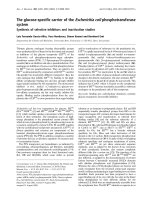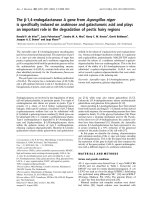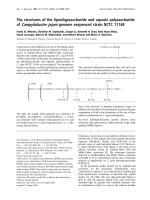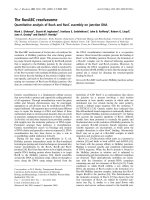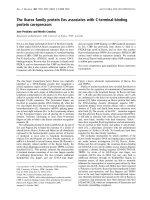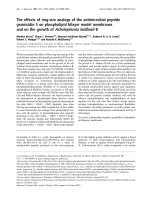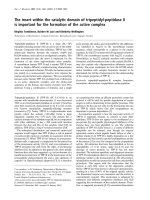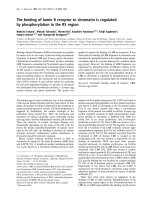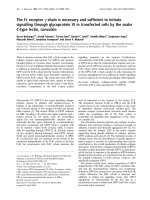Báo cáo Y học: The Emery–Dreifuss muscular dystrophy associated-protein emerin is phosphorylated on serine 49 by protein kinase A pptx
Bạn đang xem bản rút gọn của tài liệu. Xem và tải ngay bản đầy đủ của tài liệu tại đây (1.12 MB, 14 trang )
The Emery–Dreifuss muscular dystrophy
associated-protein emerin is phosphorylated
on serine 49 by protein kinase A
Rhys C. Roberts
1,
*
,‡
, Andrew J. Sutherland-Smith
1,†,‡
, Matthew A. Wheeler
2
,
Ole Norregaard Jensen
3
, Lindsay J. Emerson
2
, Ioannis I. Spiliotis
2
, Christopher G. Tate
1
,
John Kendrick-Jones
1
and Juliet A. Ellis
2
1 MRC Laboratory of Molecular Biology, Cambridge, UK
2 The Randall Division of Cell and Molecular Biophysics, Kings College, London, UK
3 Protein Research Group, Department of Biochemistry and Molecular Biology, University of Southern Denmark, Odense, Denmark
Keywords
emerin; Emery–Dreifuss muscular
dystrophy; mass spectrometry;
phosphorylation; protein kinase A
Correspondence
J. A. Ellis, The Randall Division of Cell and
Molecular Biophysics, Kings College, New
Hunts House, Guy’s Campus, London
SE1 1UL, UK
Fax: + 44 20 78486435
Tel: + 44 20 78486498
E-mail:
Present address
*The National Hospital for Neurology and
Neurosurgery, London, UK
†
Institute of Molecular Biosciences, Massey
University, Palmerston North, New Zealand
‡
These authors contributed equally to this
work
(Received 23 May 2006, revised 27 July
2006, accepted 14 August 2006)
doi:10.1111/j.1742-4658.2006.05464.x
Emerin is a ubiquitously expressed inner nuclear membrane protein of
unknown function. Mutations in its gene give rise to X-linked Emery–Drei-
fuss muscular dystrophy (X-EDMD), a neuromuscular condition with an
associated life-threatening cardiomyopathy. We have previously reported
that emerin is phosphorylated in a cell cycle-dependent manner in human
lymphoblastoid cell lines [Ellis et al. (1998) Aberrant intracellular targeting
and cell cycle-dependent phosphorylation of emerin contribute to the
EDMD phenotype. J. Cell Sci. 111, 781–792]. Recently, five residues in
human emerin were identified as undergoing cell cycle-dependent phos-
phorylation using a Xenopus egg mitotic cytosol model system (Hirano
et al. (2005) Dissociation of emerin from BAF is regulated through mitotic
phosphorylation of emerin in a Xenopus egg cell-free system. J. Biol.
Chem. 280, 39 925–39 933). In the present paper, recombinant human em-
erin was purified from a baculovirus-Sf9 heterogeneous expression system,
analyzed by protein mass spectrometry and shown to exist in at least four
different phosphorylated species, each of which could be dephosphorylated
by treatment with alkaline phosphatase. Further analysis identified three
phosphopeptides with m ⁄ z values of 2191.9 and 2271.7 corresponding to
the singly and doubly phosphorylated peptide 158-DSAYQSITHYRPV
SASRSS-176, and a m ⁄ z of 2396.9 corresponding to the phosphopeptide
47-RLSPPSSSAASSYSFSDLNSTR-68. Sequence analysis confirmed that
residue S49 was phosphorylated and also demonstrated that this residue
was phosphorylated in interphase. Using an in vitro protein kinase A assay,
we observed two phospho-emerin species, one of which was phosphorylated
at residue S49. Protein kinase A is thus the first kinase that has been iden-
tified to specifically phosphorylate emerin. These results improve our
understanding of the molecular mechanisms underlying X-EDMD and
point towards possible signalling pathways involved in regulating emerin’s
functions.
Abbreviations
AD-EDMD, autosomal dominant Emery–Dreifuss muscular dystrophy; BAF, barrier-to-autointegration factor; ER, endoplasmic
reticulum; Fe
3+
IMAC, immobilized metal affinity chromatography; PKA, protein kinase A; X-EDMD, X-linked Emery–Dreifuss muscular
dystrophy.
4562 FEBS Journal 273 (2006) 4562–4575 ª 2006 The Authors Journal compilation ª 2006 FEBS
Emerin is a ubiquitously expressed, single-membrane-
spanning protein of the inner nuclear membrane [1,2].
It is encoded by the EMD gene on chromosome Xq28
and mutations within this gene give rise to X-linked
Emery–Dreifuss muscular dystrophy (X-EDMD), a
neuromuscular condition with an associated life-threat-
ening cardiac conduction defect [3]. EDMD manifests
in early childhood with progressive weakness and wast-
ing of limb muscles and contractures at the elbows
and ankles. A cardiac conduction defect develops in
patients by their mid-30s associated with a substantial
risk of sudden death. Molecular defects are character-
ized by abnormalities in myonuclear architecture, inclu-
ding marked condensation of chromatin. The majority
of the mutations in the EMD gene produce the null
phenotype, but 10% produce modified forms of emerin.
Human emerin is a serine-rich protein of 254 amino
acids (M
r
28 994) with a C-terminal transmembrane
region (residues 222–244) which spans the inner nuclear
membrane and a hydrophilic N-terminal domain, which
orientates towards the nucleoplasm [4]. Emerin requires
the transmembrane domain and two regions in its nu-
cleoplasmic domain to be post-translationally inserted
into the endoplasmic reticulum (ER) membrane, where
it diffuses through the ER network to the nuclear envel-
ope [4–8]. Emerin is retained at the inner nuclear mem-
brane by interacting with the intermediate filament
proteins, nuclear lamin A and C [9–11]. Fluorescence
recovery after photobleaching (FRAP) and fluorescence
loss in photobleaching (FLIP) studies [5,12] show that
green fluorescent protein (GFP)-emerin has a decreased
lateral mobility when in the inner nuclear membrane
compared with when it is still in the ER [5]. This is con-
sistent with the theory that it is stably anchored at the
nuclear membrane through its interaction with lamin
A ⁄ C. Interestingly, an autosomal dominant form of
EDMD (AD-EDMD) also occurs due to mutations in
the LMNA gene, which encodes for the alternatively
spliced nuclear lamin A and C proteins [13]. Most
mutations in the LMNA gene are missense, and there-
fore modified forms of lamin A ⁄ C are produced which
frequently exhibit aberrant nuclear localization. Emerin
is re-distributed with the lamin A ⁄ C in AD-EDMD
patients [14] and to the ER in the LMNA knock-out
mouse [15], confirming that retention of emerin at the
inner nuclear membrane is, at least partly, through its
interaction with lamin A ⁄ C.
The nucleoplasmic domain of emerin and the equiv-
alent domains of two other inner nuclear membrane
proteins termed MAN1 and the lamina-associated pro-
tein isoforms (LAP1 and 2) contain a region of homol-
ogy called the LAP-Emerin-MAN1 (LEM) domain;
(residues 2–45 in human emerin). This domain is
involved in binding to a dsDNA bridging protein
termed BAF (barrier-to-autointegration factor), which
functions in higher-order chromatin organization and
nuclear assembly [16]. Other known binding partners
of emerin include the nuclear lamins A, B and C, actin
[9,17,18], the transcriptional repressors Btf [19] and
GCL [20], BAF [21], the RNA-splicing factor YT521-
B [22] and some members of the nesprin-1 and -2 nuc-
lear membrane protein family [23,24]. Such a diverse
array of binding partners suggests emerin may have a
role in regulating nuclear envelope structure and gene
expression. Indeed, it has been shown that cell cycle
timing and Rb-MyoD myogenic transcriptional path-
ways are perturbed in myoblasts isolated from EDMD
patients or emerin null mice [25,26].
Prediction analysis identifies 36 potential phosphory-
lation sites (28 Ser, one Thr and seven Tyr as
predicted by the netphos 2.0 prediction programme)
spanning human emerin residues 1–199. They cover a
wide range of kinases, including protein kinases A
and C, casein kinase II and tyrosine kinases. We have
previously shown that four different phosphorylated
forms of emerin (phospho-emerin species) can be
immunoprecipitated from phospholabelled human
lymphoblastoid cell lines [4]. Three of these phospho-
emerin species appear to be associated with cell cycle-
dependent events, although the connection with the
cell cycle remains to be directly determined. Lympho-
blastoid cell lines derived from X-EDMD patients
expressing either D95-99 or 1–218(238) mutant forms of
emerin exhibited aberrant emerin phosphorylation [4],
whereas in HeLa cells, in vivo phosphorylation of emer-
in resulted in multiple phospho-emerin species, which
were enhanced in the presence of the phosphatase 1
and 2a inhibitor, okadaic acid [27]. Consistent with
these findings, five residues in human emerin have
recently been identified as undergoing mitotic phospho-
rylation in a M-phase Xenopus egg cell-free system [28].
In this paper, we have shown by protein mass spectr-
ometry that recombinant human emerin expressed in
insect cells contains at least four phosphorylation sites,
in agreement with our previous findings in human
lymphoblastoid cell lines. We have isolated by immobi-
lized metal affinity chromatography (Fe
3+
IMAC) two
phosphopeptides and identified residue S49 as being a
phosphorylated residue by tandem mass spectrometry.
Structural prediction analysis identifies S49 as the resi-
due most likely to be phosphorylated by cAMP-depend-
ent protein kinase A (PKA) and we have confirmed this
using an in vitro protein kinase assay. Potential signal
transduction pathways that could be involved in phos-
phorylating emerin on residue S49 and how they might
influence emerin function are discussed.
R. C. Roberts et al. PKA phosphorylates emerin
FEBS Journal 273 (2006) 4562–4575 ª 2006 The Authors Journal compilation ª 2006 FEBS 4563
Results
Expression of recombinant human emerin
The two fusion proteins expressing human emerin
fragments spanning residues 1–176 and 1–220 both
expressed at high levels in bacteria. The emerin fusion
protein 1–176 expressed in the pET-29b vector with a
C-terminal 6 · His-tag was 50% soluble after treat-
ment with 1% (v ⁄ v) Triton X-100 and sonication
(Fig. 1A, lane 4). This soluble protein was purified by
Ni
2+
-NTA (nitrilotriacetic acid) and it migrated as a
single band of 30 kDa (predicted molecular mass of
20.114 kDa) on 13% SDS ⁄ PAGE (Fig. 1A, lane 5).
Immunoblotting this purified protein with our antiem-
erin AP8 antibody also produced one band (Fig. 1A,
lane 6). However, the same emerin construct
expressed with an N-terminal 6 · His-tag in insect
Sf9 cells after partial purification by Ni
2+
-NTA
migrated on 12.5% SDS ⁄ PAGE as three major and
three minor protein bands as visualized by Coomassie
blue staining (Fig. 1B; lane Co). These bands spanned
an approximate molecular mass range of 30–33 kDa.
Immunoblotting with the antiemerin antibody AP8
confirmed that all of the extra bands were emerin
and two to three higher molecular mass bands repre-
senting possible further minor emerin species were
also identified (Fig. 1B, lane IB). None of these bands
were present in uninfected control Sf9 insect cells
(data not shown). The additional forms of emerin
observed in the eukaryotic expression system are
likely to result from the addition of post-translational
modifications. The pattern of post-translational modi-
fications produced from baculovirus-expressed systems
has been shown to reflect those characterized in mam-
malian systems [29]. Our previous studies had indica-
ted that human emerin does not undergo any
proteolytic cleavage events, nor is it glycosylated, but
it is phosphorylated in mammalian cells [4,28]. As the
emerin protein bands shown in Fig. 1B are evenly
spaced, and within the limits of gel resolution differ
by the weight of a phosphate group (80 Da), this pat-
tern of bands suggests phosphorylated emerin species.
Indeed the three lowest molecular mass emerin species
cross-reacted with an antiphosphotyrosine antibody
but, perhaps not surprisingly, the commercial anti-
phosphoserine and threonine antibodies used did not
cross-react with any of the emerin bands on the blot
(data not shown). We have observed that these latter
antibodies do not cross-react with any of the phos-
phorylated cytoskeletal proteins (known to contain
phospho-serine and phospho-threonine residues) we
have tested (Kendrick-Jones, unpublished results).
The human emerin fusion protein spanning residues
1–220 expressed only as insoluble inclusion bodies
under all the conditions tested in our bacterial expres-
sion systems and attempts to re-fold this protein were
Fig. 1. Expression of recombinant emerin 1–176 in (A) the bacterial
cell line BL21 (DE3) and in (B) the insect cell line Sf9 (B). (A) 13%
SDS ⁄ PAGE of pET-29b emerin 1–176 bacterial expression (Coo-
massie blue staining): lane 1 is the un-induced cell lysate, lane 2,
the induced cell lysate, lane 3, the insoluble pellet, lane 4, the sol-
uble fraction, lane 5, the purified fraction from Ni
2+
-NTA chromato-
graphy after elution with 0.5
M imidazole treatment and lane 6 the
purified fraction immunoblotted with antiemerin antibody AP8 at a
dilution of 1:3000. Bacterially expressed emerin migrates as a sin-
gle band on SDS ⁄ PAGE (arrow). (B) FastBacHTb-emerin 1–176
expressed in the Sf9 insect cell line and purified by Ni
2+
-NTA chro-
matography and subjected to 12.5% SDS ⁄ PAGE. The recombinant
emerin 1–176 expressed in the insect FastBacHTb vector had an
additional 29 residues which adds an extra 3.53 kDa to this emerin
fusion protein compared with the same protein expressed in the
bacterial pET-29b vector. The left hand panel (Co) is Coomassie
blue stained, and the right hand panel was immunoblotted with the
antiemerin antibody AP8 (IB) at 1:3000. Baculoviral expressed
emerin migrated as a ladder of 6–9 bands. The area marked by a
boxed arrow represents the gel bands individually excised from a
Coomassie blue stained gel for the tryptic digestion.
PKA phosphorylates emerin R. C. Roberts et al.
4564 FEBS Journal 273 (2006) 4562–4575 ª 2006 The Authors Journal compilation ª 2006 FEBS
unsuccessful (data not shown). Expressing emerin 1–
220 in our insect cell expression system resulted in very
low yields with 50% of the protein insoluble, but mul-
tiple bands were apparent from immunoblotting with
the antiemerin antibody AP8. It was therefore decided
to use the more soluble purified emerin fusion protein
1–176 for mass spectrometry analysis since it still con-
tains 88% of the predicted phosphorylated sites.
Mass spectrometry analysis of recombinant
emerin 1–176
Recombinant human emerin 1–176 taken directly after
purification on the Ni
2+
-NTA column was rapidly de-
salted using a high-flow HPLC and then immediately
analyzed by ESI Q-TOF mass spectrometry (Fig. 2A).
The mass spectrum exhibited clusters of multiply
charged ions, suggesting that more than one species of
emerin was present. The raw mass spectrum was de-
convoluted using the MaxEnt algorithm (masslynx,
Waters Micromass, St Quentin, France) to reveal the
intact molecular mass of the various emerin species
(Fig. 2B). Interestingly, this revealed five different
molecular species of emerin differing by multiples of
80 Da, which is the molecular mass of a single phos-
phate group (HPO
3
). Therefore, we hypothesized that
the mass spectral peaks at 23 625, 23 705, 23 785,
23 864 and 23 944 Da corresponded to recombinant
emerin 1–176 with no phosphate and with one, two,
three and four phosphate groups attached, respectively.
Phosphorylation was confirmed by analysis of the
recombinant emerin by electrospray ionisation mass
Fig. 2. Baculovirus expressed 1–176 emerin
analyzed by ESI Q-TOF mass spectrometry.
(A) The raw spectrum illustrating the mul-
tiple charged ions corresponding to emerin
1–176. (B) The deconvoluted data of the
raw spectrum using MaxEnt algorithm,
revealing emerin as five distinct species at
23 625, 23 705, 23 785, 23 864 and
23 944 Da. The peak at 23 625 Da is non-
phosphorylated and each subsequent peak
increases by an increment of 80 Da corres-
ponding with the molecular mass of an addi-
tional phosphate group. The y axis is an
arbitrary scale and represents relative inten-
sity where 100% is taken as the most
intense peak.
R. C. Roberts et al. PKA phosphorylates emerin
FEBS Journal 273 (2006) 4562–4575 ª 2006 The Authors Journal compilation ª 2006 FEBS 4565
spectrometry (ESI-MS) following alkaline phosphatase
(ALP treatment). Now, following deconvolution of the
mass spectrum (Fig. 3A), only one peak at 23 625 Da
corresponding to the nonphosphorylated form of emer-
in was detected (Fig. 3B). Our previous studies had
indicated that human emerin does not undergo any
proteolytic cleavage events, nor is it glycosylated [4].
In agreement with these findings, the only post-transla-
tional modification we identified on human recombin-
ant emerin 1–176 by tandem mass spectrometry was
phosphorylation.
As a first step to identify the residues phosphorylat-
ed in emerin, candidate phosphopeptides were identi-
fied in tryptic digests of emerin using the MALDI-MS.
Purified recombinant emerin 1–176 was run as several
gel tracks on 12.5% SDS ⁄ PAGE, where one track was
immunoblotted for emerin and the others stained with
Coomassie blue. From the immunoblotting pattern
for emerin, a region in the adjacent Coomassie blue-
stained portion of the gel was identified as containing
the different emerin species. This region spanned an
approximate molecular mass range of 30–35 kDa
(shown as boxed arrows on the left-hand side lane Co;
Fig. 1B). The gel bands containing emerin were cut
out individually as far as was technically feasible, as
the bands were very close together and digested in-gel
with trypsin and the resulting peptides extracted. Each
individual emerin band cut out from the gel gave the
same tryptic digestion pattern upon MALDI-MS ana-
lysis of peptides. All the tryptic peptides were identified
Fig. 3. Baculovirus 1–176 emerin analyzed
by ESI Q-TOF mass spectrometry following
treatment with alkaline phosphatase (ALP).
Following incubation of emerin 1–176 with
ALP, peaks corresponding to a single un-
phosphorylated emerin species were detec-
ted. The raw data are shown in (A), while
the deconvoluted spectrum showing the
intact unphosphorylated protein peak is
shown in (B). The four emerin species lost
(compared with the peaks of 23 705.0,
23 785, 23 864, 23 944 Da on Fig. 2) repre-
sent the removal of four phosphate groups.
The y axis is an arbitrary scale and repre-
sents relative intensity where 100% is taken
as the most intense peak.
PKA phosphorylates emerin R. C. Roberts et al.
4566 FEBS Journal 273 (2006) 4562–4575 ª 2006 The Authors Journal compilation ª 2006 FEBS
to be emerin as ascertained by molecular mass deter-
mination by MALDI-MS and amino acid sequencing
by ESI tandem mass spectrometry. Phosphopeptides
were enriched by micropurification using Fe
3+
IMAC
[30] and analyzed by MALDI-MS. We identified three
candidate emerin tryptic phosphopeptides (m ⁄ z 2191.9,
2271.7 and 2396.9 on Fig. 4A,B) from one digested
band. The upper traces in both Figs 4A and 4B repre-
sent the MALDI mass spectra without prior purifica-
tion by Fe
3+
IMAC, illustrating that this purification
technique is extremely useful for enriching the phos-
phopeptides. The peptides at m ⁄ z 2191.9 and 2271.1
correspond to the peptide masses of singly and doubly
phosphorylated emerin peptide 158-DSAYQSITHYR
PVSASRSS-176 and the peptide at a m ⁄ z 2396.9
corresponds to a single phosphorylated emerin peptide
47-RLSPPSSSAASSYSFSDLNSTR-68. These phos-
pho-peptides include four of the residues reported to
be phosphorylated on emerin under mitotic conditions
(S49, S66, T67 and S175 [28]); and two reported to be
phosphorylated on emerin in human T cells (S163 and
Y167 [31]).
To pinpoint the specific phosphorylated residues,
we analyzed the tryptic peptide mixture by ESI-MS,
which produces the complex peptide mass spectrum
(Fig. 5A). The triply protonated peptide of m ⁄ z
799.791 corresponded to the potentially phosphorylat-
ed emerin peptide 47-RLSPPSSSAASSYSFSDLN
STR-68 (Fig. 5B). Tandem mass spectrometry of this
phospho-peptide candidate confirmed the identity of
the peptide and determined that the phosphorylated
residue was serine 49. The presence of a doubly
charged C-terminal fragment ion of 19 residues with
the emerin sequence (PPSSSAASSYSFSDLNSTR; m ⁄ z
980.95; labelled as y19 in Fig. 5B) demonstrated that
this peptide fragment carried no phosphate group. We
also detected an N-terminal fragment ion correspond-
ing to the sequence RLS (labelled as b3 in Fig. 5B) of
Fig. 4. Identification of candidate phospho-
peptides from 1 to 176 emerin by MALDI-
TOF MS peptide mass mapping. The tryptic
peptides from 1 to 176 emerin were extrac-
ted from the gel slices, micropurified by
Fe
3+
IMAC and introduced into the MALDI-
TOF mass spectrometer. All the protein
bands extracted had a tryptic peptide finger-
print consistent with emerin. We show the
spectrum from one peptide digest of one
individual gel slice which is the lower trace
(labelled as + IMAC) in (A) and (B). This
trace is shown in comparison with one
obtained from a tryptic peptides which were
not micropurified by Fe
3+
IMAC (upper trace
labelled –IMAC in A and B) illustrating this
purification step was necessary to selec-
tively purify the phosphorylated peptides for
detection by mass spectrometry. (A) repre-
sents the full view of all the peptides detec-
ted by MALDI mass spectrometry from m ⁄ z
600–4000 and (B) shows a magnified image
of the spectrum between m ⁄ z 2150 and
2400. Three candidate tryptic phosphopep-
tides were identified of m ⁄ z 2191.9, 2271.7
and 2396.9. The y axis is an arbitrary scale
and represents relative intensity.
R. C. Roberts et al. PKA phosphorylates emerin
FEBS Journal 273 (2006) 4562–4575 ª 2006 The Authors Journal compilation ª 2006 FEBS 4567
m ⁄ z 339.23. This fragment had lost 98 Da in molecular
mass by elimination of a phosphate group (80 Da) and
a water molecule (18 Da). Thus the detection of the
y19 and b3 ions allowed us to conclude that serine 49
was a phosphorylation site in emerin. Therefore, we
can confirm that residue S49 in human emerin is phos-
phorylated and, furthermore, as Sf9 cells do not divide
after baculovirus infection, this residue is likely to be
phosphorylated in interphase.
Does phosphorylation at residue S49 regulate its
ability to target to the nuclear envelope?
S49A and S49E mutant forms of full-length human
emerin were generated by site-directed mutagenesis
and cloned directly into the pEGFP-C2 enhanced
green fluorescent protein vector that adds the green
auto-fluorescent GFP tag to the N-terminus of emerin.
We have previously shown that the attachment of the
EGFP tag to the N-terminus of wild-type emerin does
not affect its ability to locate to the nuclear envelope
[32]. The S49A substitution generated an emerin
mutant that could not be phosphorylated at this resi-
due, whereas the S49E substitution mimicked constitu-
tive phosphorylation. These GFP-emerin constructs
were transiently expressed in an asynchronous popula-
tion of C2C12 myoblasts and wild-type GFP-emerin
correctly localized to the nuclear envelope of a cell in
interphase after 20 h which was used as the optimum
expression time (Fig. 6). The level of EGFP-emerin
expression was optimized to be similar to the level of
endogenous wild-type emerin expression, by comparing
Fig. 5. Identification of residue S49 as a
phosphorylated site in human emerin. The
tryptic peptides generated from the diges-
tion of any single Coomassie blue stained
band of Sf9 insect cell expressed 1–176
emerin (isolated from the boxed region
labelled on the LH side of Fig. 1b), were
analyzed to identify the specific residues
phosphorylated. Analysis of the tryptic
peptide mixture by ESI MS is shown in (A).
The peptide ion at m ⁄ z 799.79 was
sequenced by MS ⁄ MS (B) and identified the
phosphopeptides 47-RLSPPSSSAASSYSF
SDLNSTR-68. The presence of the phos-
phopeptides fragment ion y19 and b3 in this
MS ⁄ MS spectrum allowed us to identify
serine 49 as a site of phosphorylation in
emerin (B).
PKA phosphorylates emerin R. C. Roberts et al.
4568 FEBS Journal 273 (2006) 4562–4575 ª 2006 The Authors Journal compilation ª 2006 FEBS
immunofluorescence intensities of endogenous emerin
stained with our AP8 antiemerin antibody with EGFP-
emerin stained with an anti-GFP antibody (data not
shown). The transfection efficiency (10%) and level of
EGFP-protein expression was similar for all three
EGFP constructs. Since the nuclear-trafficking route
for emerin involves prior transit through the ER net-
work [7,8], some emerin is always seen in the ER of
interphase cells, as shown by the staining for the ER
with an anti-PDI antibody (merge panel; Fig. 6).
C2C12 cells expressing the EGFP-emerin S49A mutant
exhibited a wild-type distribution, although some pro-
tein aggregation was observed in the perinuclear region
(Fig. 6). Similar aggregates were seen in cells expres-
sing the EGFP-emerin S49E mutant. The aggregates of
exogenous mutant emerin protein did not colocalize
with staining for Golgi-associated protein (GM130),
coat associated protein of non-clathrin-coated vesicles
(b-COP) (data not shown) and protein disulfide iso-
merase (PDI) (Fig. 6), suggesting they were located in
the cytoplasm and therefore excluded from the ER
and thus unable to be transported to the nuclear envel-
ope. These aggregates were most likely the result of
misfolding of the mutant fusion proteins. Endogenous
lamin A ⁄ C staining was normal in all our transfected
cells and we saw no evidence for structural alterations
to the nuclear envelope or rearrangement of hetero-
chromatin (data not shown). Interestingly, in 90% of
the myoblasts expressing the EGFP-emerin S49E
mutant, consistently slightly less exogenous emerin was
expressed at the nuclear membrane (Fig. 6) compared
with wild-type EGFP-emerin in interphase cells. How-
ever, if we allowed our transfected cells to undergo
one round of cell division, both mutants targeted
directly to the nuclear envelope in a similar manner to
wild-type emerin (data not shown). These results sug-
gest that newly synthesized endogenous emerin is
either unphosphorylated at residue S49 and ⁄ or that
phosphorylation at this site is not crucial for its nuc-
lear envelope targeting. It is therefore probable that
phosphorylation on residue S49 regulates its interac-
tions with one or more of its nuclear binding partners,
Fig. 6. Intracellular localization of wild-type,
S49A and S49E emerin tagged with EGFP in
C2C12 cells. An asynchronous population of
C2C12 myoblasts were transfected with our
pEGFP-C2 emerin constructs as described
in the Experimental procedures. The cells
were fixed )20 °C methanol and the intra-
cellular location of emerin was monitored by
EGFP (green) fluorescence, the endoplasmic
reticulum staining was monitored by PDI
staining (red) and chromatin with DAPI
(blue). The merged panel illustrates some
emerin being present in the ER (yellow).
Bar ¼ 10 lm.
R. C. Roberts et al. PKA phosphorylates emerin
FEBS Journal 273 (2006) 4562–4575 ª 2006 The Authors Journal compilation ª 2006 FEBS 4569
whilst at the nuclear envelope. We therefore examined
the effect of phosphorylation at residue S49 on emer-
in’s ability to interact with lamin A and C. Using
our coimmunoprecipitation ⁄ in vitro transcription-trans-
lation assay system described previously [33] we dem-
onstrate that both the S49A and S49E- mutant forms
of emerin appear to bind to either lamin A or lamin C
with the same relative affinity as wild-type emerin
(data not shown). Therefore, phosphorylation at resi-
due S49 is unlikely to directly regulate emerin-lamin
A ⁄ C interaction in vivo.
Protein kinase A-dependent phosphorylation of
serine 49
Computer prediction analysis using the scansite 2.0
motif scan computer programme [34] set at the high-
est stringency setting (score falls within the top 0.2%
of known motifs) identified emerin residue S49 as
being the most likely residue in emerin to be phosphor-
ylated by cAMP-dependent PKA [28]. In addition, no
other kinase was predicted to phosphorylate residue
S49, using the scansite 2.0 programme. We experi-
mentally verified this to be the case using an in vitro
PKA-dependent assay on purified wild type and S49A
mutant (1–176) 6 · His-tagged emerin fusion proteins.
The purified S49A fusion protein expressed in bacteria
migrated at a slightly lower molecular mass than wild
type upon Coomassie blue staining on SDS ⁄ PAGE
(data not shown). When we performed the in vitro
PKA assay on both the purified wild-type and S49A
mutant emerin 1–176 fusion proteins, we observed two
and one distinct phospho-emerin bands, respectively,
when separated by 1D SDS ⁄ PAGE (Fig. 7). When this
experiment was repeated in the presence of the PKA
inhibitor, H-89, all PKA phosphorylated forms of em-
erin were absent (Fig. 7). These results provide good
evidence that S49 is phosphorylated by PKA and that
there is probably at least one other residue within em-
erin which is also phosphorylated by a PKA-dependent
mechanism. Possible candidates for this second residue
are S66, T67, S120, S163 and S175, with residue S120
giving the highest score using the scansite 2.0 pro-
gramme set at a medium stringency setting.
Discussion
We have previously shown that emerin can occur in
at least four differently phosphorylated forms in
human lymphoblastoid cells, three of which are asso-
ciated with cell cycle-dependent events [4]. In this
paper, we have used mass spectrometry to detect
five different species of human recombinant emerin
expressed in insect cells, and identified serine 49 as
being phosphorylated by a PKA-dependent mechan-
ism. Whilst this manuscript was in preparation,
Hirano et al. [28] reported the identification of five
residues in human emerin which undergo cell cycle-
dependent phosphorylation. This included residue
S49, as well as S66, T67, S120 and S175, all of
which, except S120, are contained within the two
phosphopeptides we isolated. Similarly, neither they
nor we identified any phosphorylated residues in the
LEM domain. In addition, both groups present evi-
dence that there remain many more phosphorylation
sites to be identified. Indeed, whilst carrying out a
phospho-proteomic profiling screen of tyrosine phos-
phorylation sites in proteins of human T cells, Brill
et al. [31] reported two additional residues, S163 and
Y167, which are phosphorylated in human emerin.
These too are within our second phosphopeptide. The
identification of residue Y167 as being a site of phos-
phorylation is in agreement with our findings of
immunoblotting our baculovirus-Sf9 expressed emerin
protein with a phospho-tyrosine antibody, which
recognized one emerin species. Thus three different
scientific approaches to elucidate the phosphorylated
sites in human emerin have produced similar results.
Residue S49 has been shown to be surface exposed
and therefore accessible for protein–protein interac-
tions and to both protein kinases and phosphatases
[35]. It is also conserved in emerin from Rattus norve-
gicus, Bos taurus and Caenorhabditis elegans and there-
Fig. 7. Residue S49 is phosphorylated by a protein kinase A-
dependent mechanism. Approximately 5 lg of purified wild-type
and S49A mutant (1–176) 6 · His tagged emerin fusion proteins
were incubated in a PKA-dependent assay as described in Experi-
mental procedures. The purified 1–176 S49A emerin fusion protein
migrates at a lower molecular mass than its wild type counterpart
by Coomassie blue stained SDS ⁄ PAGE gel (data not shown).
Fusion proteins were incubated under three different experimental
conditions: (i) without either PKA or H-89; (ii) with PKA and (iii) with
PKA and H89. All protein samples were separated on a 12%
SDS ⁄ PAGE gel and autoradiography performed. Two phospho-em-
erin species were observed with wild-type emerin, which was
reduced to one for the S49A mutant. Addition of the PKA inhibitor
H-89 disrupted phosphorylation at both of these sites.
PKA phosphorylates emerin R. C. Roberts et al.
4570 FEBS Journal 273 (2006) 4562–4575 ª 2006 The Authors Journal compilation ª 2006 FEBS
fore phosphorylation at this site is likely to have func-
tional consequences. Although we were unable to show
a direct effect of phosphorylation on emerin’s interac-
tion with lamin A or C, it may affect emerin’s binding
to its other binding partners. In the human emerin
sequence, residue S49 is located just outside the glob-
ular LEM domain [35] and phosphorylation at this site
could therefore regulate emerin’s interaction with
BAF. However, emerin requires BAF for its assembly
into a reforming nuclear envelope [36] and our data
suggests that phosphorylation at residue S49 does not
have a significant effect on emerin’s targeting to a reas-
sembling nuclear envelope. Phosphorylation at S49
may also regulate emerin’s interaction directly with
Btf, GCL or YT521-B, since their binding sites all
encompasses this residue [37]. If this proves to be the
case, then the X-EDMD patient with the mutation
S54F (which is in the Btf binding region), where emer-
in has been shown to bind with a reduced affinity to
Btf [19], may also be affected by phosphorylation at
residue S49. In addition, emerin phosphorylation
maybe involved in regulating the formation of ternary
or higher multiprotein complexes containing emerin.
For instance, it is known that BAF and GCL compete
to form either emerin–BAF–lamin A or emerin–GCL–
lamin A complexes [20] and phosphorylation of any of
these proteins could regulate these interactions.
We have shown that at least two residues in emerin
are phosphorylated in a PKA-dependent manner, one
of which we identified as S49. This is consistent with
earlier results describing the isolation of a large protein
complex consisting of PKA, the A-kinase anchoring
protein AKAP149, protein phosphatase 1, nuclear
lamins, emerin and actin from both differentiating
myoblasts and mature myotubes [17,38]. Indeed these
results suggested that PKA might regulate the emerin–
actin interaction [17], with dephosphorylation enhan-
cing their interaction, although it was not clear
whether this was directly due to the effect of PKA
phosphorylation on emerin. However, our results sug-
gest that PKA phosphorylation could provide a mech-
anism for regulating the role of emerin in organizing a
nuclear actin cortical network [18]. Furthermore,
nesprin-1a has been shown to be the receptor for
AKAP149 at the nuclear envelope in neonatal rat car-
diomyocytes [39] and it has the tightest affinity for
emerin of any of its known binding partners. This sug-
gests that nesprin, in addition to lamin A ⁄ C, anchors
emerin to the nuclear envelope and is also involved in
localizing PKA signalling at the nuclear envelope.
Indeed, PKA-mediated phosphorylation of emerin con-
taining complexes would explain the apparent link
between emerin phosphorylation and cell cycle-depend-
ent events, since PKA is activated as a downstream
consequence of cdc2 kinase activity [40].
In conclusion, our results suggest that emerin is
potentially a multiphosphorylated protein and phos-
phorylation may be crucial in regulating its binding
interactions with its large number of binding partners.
Apart from PKA it is likely that several other known
Ser-Thr ⁄ Tyr kinases or even an emerin-specific kinase
may be present as components of the emerin nuclear
protein complex, as is observed for the lamin B recep-
tor [41]. The identification of a specific kinase that
phosphorylates emerin will allow us to target specific
signalling pathways to elucidate the molecular mecha-
nisms underlying X-EDMD.
Experimental procedures
Recombinant expression and purification of
human emerin
The human emerin constructs encoding amino acids 1–176
and 1–220 were generated by PCR using full length emerin
in pBluescript KS- as the template [4]. The amplified
sequences were confirmed by sequencing and subcloned
5¢-BamH1-Sal1–3¢ into the bacterial expression vectors
pET-29b (Novagen; C-terminal 6 · His tag) and pGEX-
4T-3 (Pharmacia Biotech Inc, Piscataway, NJ, USA; N-ter-
minal tagged glutathione S-transferase) and into the insect
cell expression vector, FastBacHTb (Bac-to-Bac expression
system, Invitrogen, Ltd., Paisley, UK encoding an N-ter-
minal 6x His tag).
Recombinant baculovirus was prepared as described in
the Bac-to-Bac manual (Invitrogen). Sf9 cells were infected
with recombinant virus to express emerin and cell pellets
harvested by centrifugation at 4000 g and frozen in liquid
nitrogen. Infected insect cell pellets expressing emerin 1–176
were thawed and resuspended in 20 mm Tris pH 8.0, 25%
(w ⁄ v) sucrose, 1 mm EDTA, 2 mm MgCl
2
and complete pro-
tease inhibitor cocktail (Roche, Basel, Switzerland). Samples
were refrozen in liquid nitrogen and allowed to defrost at
room temperature before sonication to induce cell lysis. The
samples were spun at 174 000 g for 15 min at 4 °C, with the
resulting supernatant applied to Ni
2+
-NTA spin columns
(Qiagen, Dorking, UK) previously washed with 20 mm Tris
pH 8.0, 300 mm NaCl, 3 mm 2-mercaptoethanol. Histidine
tagged emerin 1–176 bound to the Ni
2+
-NTA spin column
during centrifugation at 700 g for 4 min whilst unbound
protein was eluted. Contaminating proteins were further
removed by centrifugation wash steps of 20 mm Tris pH 8.0,
300 mm NaCl, 3 mm 2-mercaptoethanol, followed by further
washes with the same buffer augmented with 10 mm imidaz-
ole. Emerin 1–176 was eluted from the Ni
2+
-NTA spin
column with 20 mm Tris pH 8.0, 300 mm NaCl, 250 mm
imidazole, and 3 mm 2-mercaptoethanol. Any aggregated
R. C. Roberts et al. PKA phosphorylates emerin
FEBS Journal 273 (2006) 4562–4575 ª 2006 The Authors Journal compilation ª 2006 FEBS 4571
material was removed by centrifugation at 174 000 g for
15 min and the imidazole was removed by extensive dialysis
against 20 mm Tris, pH 8.0, 300 mm NaCl, 3 mm 2-merca-
ptoethanol. Post-translational modification of expressed
emerin 1–176 was examined by 12.5% SDS ⁄ PAGE and
immunoblotting with the antiemerin antibody AP8 [4].
cDNA emerin, lamin A and C constructs
Site-directed mutagenesis was performed by overlap exten-
sion PCR protocols using Pfu DNA polymerase (Strata-
gene, Amsterdam, the Netherlands) from the full-length
human emerin wild-type cDNA clone in pBluescript KS- to
synthesis the emerin S49A and S49E mutants [9]. The
restriction enzyme sites HindIII and BamHI were incor-
porated at the 5¢- and 3¢-ends, respectively. The PCR
fragments generated were cloned into the pEGFP-C2
(Clontech, Palo Alto, CA, USA) and sequenced in their
entirety by Oswel Research Products Ltd (Southampton,
UK). They were then subcloned into pcDNA3.1 (Invitro-
gen), 5¢ HindIII-BamHI- for the in vitro transcription-trans-
lation assays. Full-length wild-type human lamin A and
lamin C cDNAs in pcDNA3.1 (Stratagene) were generated
[33]. For the PKA assay, C-terminal His-tagged wild-type
and S49A mutant emerin (1–176) fusion proteins were sub-
cloned into vector pET-28c, expressed and purified.
Cell culture, transfection and antibodies
C2C12 mouse fibroblast cells were cultured using Dul-
becco’s modified Eagle’s medium, supplemented with 10%
fetal bovine serum, 2 mm glutamine and penicillin ⁄ strepto-
mycin (complete medium). Cells were grown at 37 °C
in 5% CO
2
, and passaged at 80% confluence using
trypsin ⁄ EDTA. C2C12 cells were transfected with either
EGFP-S49A or EGFP-S49E emerin according to the Lipo-
fectamine
TM
Transfection Protocol of Invitrogen
TM
. Cells
were transfected for 4 h and a time course for optimal
expression levels was performed. Cells were fixed with
methanol at )20 °C and analyzed for EGFP-emerin fluores-
cence, endogenous lamin A ⁄ C (Jol 5 at 1:100; ImmuQuest
Ltd., Ingleby Barwick, UK), protein disulphide isomerase
(PDI; ER lumenal protein at 1:50, BD Transduction Labor-
atories, Oxford, UK), GM130 (Golgi-associated protein at
1:50, BD Transduction Laboratories), b-COP (coat-associ-
ated protein of nonclathrin-coated vesicles at 1:50, Sigma,
Poole, UK) localization.
Secondary antibodies used included goat antimouse and
antirabbit IgG conjugated with rhodamine at 1:100 (Chem-
icon, Chandlers Ford, UK) for double labelling in our im-
munofluorescence experiments. A rabbit polyclonal affinity-
purified antiemerin antibody AP8 was used at a dilution of
1:2000 for immunoblotting emerin fusion proteins [4]. An
antiphosphotyrosine antibody PY20 (Zymed Laboratories,
San Francisco, CA, USA) and an antithreonine antibody
(Cell Signalling Technology, Danvers, MA, USA) were both
used at a dilution of 1:5000 (in 2 mgÆmL
)1
bovine serum
albumin in NaCl ⁄ P
i
). An antiphosphoserine antibody
(Sigma P-3430) was used at a dilution of 1:500. All the
phospho-antibodies were incubated overnight at 4 °Con
immunoblots of baculovirus expressed recombinant emerin.
Immunofluorescence microscopy
Transfected C2C12 cells were prepared for immunofluores-
cence microscopy as described previously [9]. A Zeiss Axio-
plan 2 (Carl Zeiss Ltd., Welwyn Garden City, UK) with a
Zeiss Plan-Neofluar 40X lens having a numerical aperture
of 0.75 and the appropriate rhodamine and GFP emission
filters was used. Pictures were taken with a Hamamatsu
Orca-ER camera (Zeiss) and digitally processed with open-
lab 3.0.9 (Improvision, Coventry, UK) and adobe photo-
shop 6.1.1 software.
In vitro synthesis of radiolabelled emerin and
immunoprecipitation
For binding assays and subsequent immunoprecipitation of
the bound proteins, wild-type emerin, lamin A and C as well
as the mutant emerin S49A and S49E cDNA constructs in
pcDNA3.1 were synthesized in vitro using the coupled tran-
scription-translation TNT T7 polymerase coupled Reticulo-
cyte Lysate System (Promega, Southampton, UK), as
described previously [4,33]. Synthesized proteins were labell-
ed with l-[
35
S] methionine (Amersham Biosciences, Little
Chalfont, UK) in a final volume of 25 lL. Protein products
were separated on 10% SDS ⁄ PAGE gels and radiolabelled
proteins visualized by autoradiography with Kodak BIO-
MAX-MR film (Kodak, Rochester, NY, USA). The in vitro
binding assays were performed as described previously [33].
Protein kinase A assay
Approximately 5 lg of either wild-type or S49A mutant
emerin (1–176) 6 · His-tagged purified fusion protein were
incubated with 50 U of Bovine heart protein kinase A
catalytic subunit (Sigma) and 10 lCi [
32
P]ATP[cP]
(10 mCiÆmL
)1
) (Amersham) in reaction buffer (20 mm Tris
pH 7.5, 100 mm NaCl, 12 mm MgCl
2
) for 15 min at 30 °C
(method adapted from [42]). The reaction was stopped by
adding 25 lL2· SDS ⁄ PAGE sample buffer. To test for
PKA specificity, both emerin fusion proteins were incuba-
ted with the PKA inhibitor H-89 (10 lm) (Sigma) for
30 min at 4 °C. Each fusion protein was then incubated
with protein kinase A and [
32
P]ATP[cP] as described above.
To rule out autophosphorylation, each fusion protein was
incubated with [
32
P]ATP[cP] in the absence of protein
kinase. All protein samples were separated on a 12%
SDS ⁄ PAGE gel and autoradiography performed.
PKA phosphorylates emerin R. C. Roberts et al.
4572 FEBS Journal 273 (2006) 4562–4575 ª 2006 The Authors Journal compilation ª 2006 FEBS
Mass spectrometry
A quadrupole time-of-flight tandem mass spectrometer fit-
ted with a nanoelectrospray ionization (nanoESI) Z–spray
interface (Q-TOF I, Waters ⁄ Micromass, Manchester, UK)
was used to analyze the full length baculovirus-expressed
emerin (1–176) 6 · His-tagged construct at the University
of Southern Denmark. Briefly, the protein was desalted on
a Poros 20 R1 reverse phase liquid chromatography system
with 0.05% trifluoroacetic acid for 1 min. The expressed
emerin protein was then eluted directly into the electrospray
source using 70% acetonitrile ⁄ 0.05% trifluoroacetic acid
with a flow rate of approximately 20 lLÆmin
)1
. To deter-
mine whether the extra emerin bands were due to phos-
phorylation, 19 lg of purified recombinant emerin was
treated with and without 10 U of calf intestinal alkaline
phosphatase (ALP; Roche, 0108138) at 37 °C for 90 min in
25 mm Tris ⁄ HCl, 1 mm MgCl
2
, 0.1 mm ZnCl
2
, pH 8.0
(ALP buffer) and immediately desalted and analyzed by
Q-TOF mass spectrometry.
For peptide analysis, MALDI TOF MS (REFLEX II,
Bruker–Daltonics, Bremen, Germany) with delayed extrac-
tion and ion reflector was used. 2,5-Dihydroxybenzoic acid
was used as the matrix for all phosphopeptide analysis.
Tryptic peptides from SDS ⁄ PAGE separated emerin were
prepared using the method previously described [43]. To
selectively purify phosphopeptides from tryptic peptide mix-
tures, Fe
3+
IMAC [30] was used prior to analysis by mass
spectrometry. Spectra were analyzed and annotated using
moverz (Genomic Solutions, Ann Arbor, MI, USA).
Peptide sequencing by tandem mass spectrometry was
performed using the Q-TOF I mass spectrometer fitted with
a nanoESI Z–spray interface. The instrument was set in
positive ion mode with the following typical settings: needle
700–1000 V; cone 55 V; collision gas (argon) pressure 5.5–
6.0 · 10
)5
atm; collision energy over a range of 4–34 eV.
Peptide fragmentation data were analyzed using the mass-
lynx provided by Waters ⁄ Micromass.
Acknowledgements
This work was funded by an MRC studentship and
Marie Curie Fellowship awarded to RCR and Muscu-
lar Dystrophy Campaign project grants awarded
to AJS-S (RA3 ⁄ 593) and JAE (RA3 ⁄ 577 and
RA3 ⁄ 655) and a grant from the Danish Natural Sci-
ences Research Council (ONJ). ONJ is a Lundbeck
Foundation Research Professor.
References
1 Nagano A, Koga R, Ogawa M, Kurano Y, Kawada J,
Okada R, Hayashi YK, Tsukahara T & Arahata K
(1996) Emerin deficiency at the nuclear membrane in
patients with Emery–Dreifuss muscular dystrophy. Nat
Genet 12, 254–259.
2 Manilal S, thi Man N, Sewry CA & Morris GE (1996)
The Emery–Dreifuss muscular dystrophy protein, emer-
in, is a nuclear membrane protein. Hum Mol Genet 5,
801–808.
3 Bione S, Maestrini E, Rivella S, Nancini M, Regis S,
Romeo G & Toniolo D (1994) Identification of a novel
X-linked gene responsible for EDMD. Nat Genet 8,
323–327.
4 Ellis JA, Craxton M, Yates JRW & Kendrick-Jones J
(1998) Aberrant intracellular targeting and cell cycle-
dependent phosphorylation of emerin contribute to the
EDMD phenotype. J Cell Sci 111, 781–792.
5 Ostlund C, Bonne G & Schwartz & Worman HJ (2001)
Properties of lamin A mutants found in EDMD, cardio-
myopathy and Dunnigan-type partial lipodystrophy.
J Cell Sci 114, 4435–4445.
6 Tsuchiya Y, Hase A, Ogawa M, Yorifuji H & Arahata
K (1999) Distinct regions specify the nuclear membrane
targeting of emerin, the responsible protein for Emery–
Dreifuss muscular dystrophy. Eur J Biochem 259, 859–
865.
7 Soulham B & Worman HJ (1995) Signals and structural
features involved in integral membrane protein targeting
to the inner nuclear membrane. J Cell Biol 130, 15–27.
8 Ellenberg J, Siggia ED, Moreira JE, Smith CL, Presley
JF, Worman HJ & Lippincott-Schwartz J (1997)
Nuclear membrane dynamics and reassembly in living
cells: targeting of an inner nuclear membrane protein in
interphase and mitosis. J Cell Biol 138, 1193–1206.
9 Fairley EAL, Kendrick-Jones J & Ellis JA (1999) The
EDMD phenotype arises from aberrant targeting and
binding of emerin at the inner nuclear membrane. J Cell
Sci 112, 2571–2582.
10 Clements L, Manilal S, Love DR & Morris GE (2000)
Direct interaction between emerin and lamin A. Bio-
chem Biophys Res Commun 267, 709–714.
11 Sakaki M, Koike H, Takahashi T, Sasagawa N, Tomi-
oka A, Arahata K & Ishiura S (2001) Interaction
between emerin and nuclear lamins. J Biochem 129,
321–327.
12 Shimi T, Koujin T, Segura-Totten M, Wilson KL,
Hiraoka Y & Haraguchi T (2004) Dynamic interaction
between BAF and emerin revealed by FRAP, FLIP and
FRET analyses in living HeLa cells. J Struc Biol 147,
31–41.
13 Bonne G, Raffaele Di Barletta M, Varnous S, Becane
H-M, Hammouda E-H, Merlini L, Muntoni F, Green-
berg CR, Gary F, et al. (1999) Mutations in the gene
encoding lamin A ⁄ C cause AD-EDMD. Nat Genet 21,
285–288.
14 Favreau C, Dubosclard E, Ostlund C, Vigouroux C,
Capeau J, Wehnert M, Higuet D, Worman HJ,
R. C. Roberts et al. PKA phosphorylates emerin
FEBS Journal 273 (2006) 4562–4575 ª 2006 The Authors Journal compilation ª 2006 FEBS 4573
Courvalin J-C & Duendia B (2003) Expression of lamin
A mutated in the carboxy-terminal tail generates an
aberrant nuclear phenotype similar to that observed in
patients with Dunnigan-type partial lipodystrophy and
EDMD. Exp Cell Res 282, 14–23.
15 Sullivan T, Escalante-Alcalde D, Bhatt H, Anver M,
Bhat N, Nagashima K, Steward CL & Burke B (1999)
Loss of A-type lamin expression compromises nuclear
envelope integrity leading to muscular dystrophy. J Cell
Biol 147, 913–919.
16 Segura-Totten M, Kowalski AK, Craigie R & Wilson
KL (2002) Barrier-to-autointegration factor: major roles
in chromatin decondensation and nuclear assembly.
J Cell Biol 158, 475–485.
17 Lattanzi G, Cenni V, Marmiroli S, Capanni C, Mattioli
E, Merlini L, Squarzoni S & Maraldi NM (2003) Asso-
ciation of emerin with nuclear and cytoplasmic actin is
regulated in differentiating myoblasts. Biochem Biophys
Res Commun 303, 764–770.
18 Holaska JM, Kowalski AK & Wilson KL (2004)
Emerin caps the pointed end of actin filaments: Evi-
dence for an actin cortical network at the nuclear inner
membrane. PLOS Biol. 2, e231.
19 Haraguchi T, Holaska JM, Yamane M, Koujin T,
Hashiguchi N, Mori C, Wilson KL & Hiraoka Y (2004)
Emerin binding to Btf, a death-promoting transcrip-
tional repressor, is disrupted by a missense mutation
that causes Emery–Dreifuss muscular dystrophy. Eur J
Biochem 271, 1035–1045.
20 Holaska JM, Lee KK, Kowalski AK & Wilson KL
(2003) Transcriptional repressor germ cell-less (GCL)
and barrier-to-autointegration factor (BAF) compete
for binding to emerin in vitro. J Biol Chem 278, 6969–
6975.
21 Lee KK, Haraguchi T, Lee RS, Koujin T, Hiraoka Y &
Wilson KL (2001) Distinct functional domains in
emerin bind lamin A and DNA-bridging protein BAF.
J Cell Sci 114, 4567–4573.
22 Wilkinson FL, Holaska JM, Zhang Z, Sharma A,
Manilal S, Holt I, Stamm S, Wilson KL & Morris GE
(2003) Emerin interacts in vitro with the splicing-asso-
ciated factor, YT521-B. Eur J Biochem 270, 2459–2466.
23 Zhang Q, Skepper JN, Yang F, Davies JD, Hegyi L,
Roberts RG, Weissberg PL, Ellis JA & Shanahan CM
(2001) Nesprins: a novel family of spectrin-repeat-
containing proteins that localize to the nuclear mem-
brane in multiple tissues. J Cell Sci 114, 4485–4498.
24 Zhang Q, Ragnauth CD, Skepper JN, Worth NF, War-
ren DT, Roberts RG, Weissberg PL, Ellis JA & Shana-
han CM (2005) Nesprin-2 is a multi-isomeric protein
that binds lamin and emerin at the nuclear envelope
and forms a subcellular network in skeletal muscle.
J Cell Sci 118, 673–687.
25 Melcon G, Kozlov S, Cutler DA, Sullivan T, Hernandez
L, Zhao P, Mitchell S, Nader G, Bakay M, Rottman
JN, et al. (2006) Loss of emerin at the nuclear envelope
disrupts the Rb1 ⁄ E2F and MyoD pathways during
muscle regeneration. Hum Mol Gens 15, 637–651.
26 Bakay M, Wang Z, Melcon G, Schiltz L, Xuan J,
Zhao P, Sartorelli V, Seo J, Pegorara E, Angelini C,
et al. (2006) Nuclear envelope dystrophies show tran-
scriptional fingerprint suggesting disruption of Rb-
MyoD pathways in muscle regeneration. Brain 126 ,
996–1013.
27 Cartegni L, di Barletta RM, Barresi R, Squarzoni S,
Sabatelli P, Maraldi NM, Mora M, Di Blasi C, Corne-
lio F, Merlini L, et al. (1997) Heart specific localization
of emerin: new insights into Emery–Dreifuss muscular
dystrophy. Hum Mol Genet 6, 2257–2264.
28 Hirano Y, Segawa M, Ouchi FS, Yamakawa Y, Fur-
ukawa K, Takeyasu K & Horigome T (2005) Dissocia-
tion of emerin from BAF is regulated through mitotic
phosphorylation of emerin in a Xenopus egg cell-free
system. J Biol Chem 280, 39925–39933.
29 Grisshamer R & Tate CG (1995) Overexpression of
integral membrane proteins for structural studies. Quart
Revs Biophys 28, 315–422.
30 Stensballe A, Anderson S & Jensen ON (2001) Char-
acterisation of phosphoproteins from electrophoretic
gels by namoscale Fe(III) affinity chromatography
with off-line mass spectrometry analysis. Proteomics 1,
207–222.
31 Brill LM, Salomon AR, Ficarro SB, Mukherji M, Stell-
er-Gill M & Peters EC (2004) Robust phosphoproteo-
mic profiling of tyrosine phosphorylation sites from
human T cells using immobilised metal affinity chroma-
tography and tandem mass spectrometry. Anal Chem
76, 2763–2772.
32 Fairley EAL, Riddell A, Ellis JA & Kendrick-Jones J
(2002) The cell cycle dependent mislocalisation of
emerin may contribute to the EDMD phenotype. J Cell
Sci 115, 341–354.
33 Motsch I, Kaluarachchi M, Emerson LJ, Brown CA,
Brown SC, Dabauvalle M-C & Ellis JA (2005) Lamin
A and lamin C are differentially dysfunctional in
autosomal dominant EDMD. Eur J Cell Biol 84,
765–781.
34 Obenauer JC, Cantley LC & Yaffe MB (2003) Scansite
2.0: proteome-wide prediction of cell signalling interac-
tions using short sequence motifs. Nucleic Acids Res 31,
3635–3641.
35 Wolff N, Gilquin B, Courchay K, Callebaut I, Worman
HJ & Zinn-Justin S (2001) Structural analysis of emerin,
an inner nuclear membrane protein mutated in X-linked
Emery–Dreifuss muscular dystrophy. FEBS Lett 501,
171–176.
36 Haraguchi T, Koujin T, Segura-Totten M, Lee KK,
Matsuoka Y, Yoneda Y, Wilson KL & Hiraoka Y
(2001) BAF is required for emerin assembly into the
reforming nuclear envelope. J Cell Sci 114, 4575–4585.
PKA phosphorylates emerin R. C. Roberts et al.
4574 FEBS Journal 273 (2006) 4562–4575 ª 2006 The Authors Journal compilation ª 2006 FEBS
37 Bengtsson L & Wilson KL (2004) Multiple and surpris-
ing new functions for emerin, a nuclear membrane pro-
tein. Curr Opin Cell Biol 16, 73–79.
38 Bonne G, Yaou R, Beroud C, Boriani G, Brown S, de
Visser M, Duboc D, Ellis J, Hausmanowa-Petrusewicz
Lattanzi G, Merlini L, et al. (2003) 7th International
EDMD Workshop meeting report. Neuromusc Disord
13, 508–515.
39 Pare GC, Easlick JL, Mislow JM, McNally EM &
Kapiloff MS (2005) Nesprin-1a contributes to the tar-
geting of mAKAP to the cardiacmyocyte nuclear envel-
ope. Exp Cell Res 303, 388–399.
40 Hohmann P, DenHaese G & Greene RS (1993) Mitotic
CDC2 kinase is negatively regulated by cAMP-depen-
dent protein kinase in mouse fibroblast cell free extracts.
Cell Prolif 26, 195–204.
41 Nikolakaki E, Simos G, Georgatos SD & Giannakouros
T (1996) A nuclear envelope-associated kinase phos-
phorylates arginine-serine motifs and modulates interac-
tions between the lamin B receptor and other nuclear
proteins. J Biol Chem 271, 8365–8372.
42 Nakamura T, Shibata N, Nishimoto-Shibata T, Feng
D, Ikemoto M, Motojima K, Iso ON, Tsukamoto K,
Tsujimoto M & Arai H (2005) Regulation of SR-BI
protein levels by phosphorylation of its associated pro-
tein, PDZK1. Proc Natl Acad Sci USA 102, 13404–
13409.
43 Jensen ON, Wilm M, Shevchenko A & Mann M (1999)
Sample preparation methods for mass spectrometric
peptide mapping directly from 2-DE gel. Methods Cell
Biol 112, 513–530.
R. C. Roberts et al. PKA phosphorylates emerin
FEBS Journal 273 (2006) 4562–4575 ª 2006 The Authors Journal compilation ª 2006 FEBS 4575
